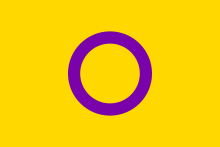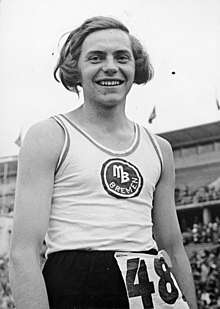Sex verification in sports
Sex verification in sports (also known as gender verification, or loosely as gender determination or a sex test) occurs because eligibility of athletes to compete is restricted (in theory) whenever sporting events are limited to a single sex, which is generally the case, as well as when events are limited to mixed-sex teams of defined composition (e.g., most pairs events). Practice has varied tremendously over time, across borders and by competitive level. Issues have arisen multiple times in the Olympic games and other high-profile sporting competitions, for example allegations that certain male athletes attempted to compete as women or that certain female athletes had intersex conditions that gave unfair advantage.
| Intersex topics |
|---|
 |
|
Medicine and biology |
|
History and events |

The first mandatory sex test issued by the International Association of Athletics Federations (IAAF), the world's track and field governing body, for woman athletes was in July 1950 in the month before the European Championships in Belgium. All athletes were tested in their own countries.[1] Sex testing at the actual games began with the 1966 European Athletics Championships’ response to suspicion that several of the best women athletes from the Soviet Union and Eastern Europe were actually men. At the Olympics, testing was introduced in 1968.[2][3][4] In some cases, these policies have led to athletes undergoing unnecessary surgery such as female genital mutilation and sterilization.[4] Subsequent reports have shown that the tests could cause psychological harm. Sex verification—identifying athletes whose hormone levels are abnormal compared to others of their purported sex — can cause sex identity crises, elicit demeaning reactions (publicly and privately), isolate athletes socially, and lead to depression and sometimes suicide.[5]
History
Initially, sex verification took the form of physical examinations. It subsequently evolved into chromosome testing, later testosterone level testing. It is not always simply checking whether a person's sex chromosome pair[lower-alpha 1] is XX vs. XY, or comparing their levels of key sex hormones to distinct reference ranges, to determine an athlete's sex. Variations in pairings of inherited chromosome, other genetic aspects, and pre- and postnatal physical development at subcellular to organ levels mean some people are not unambiguously female or male. Fetuses start out as undifferentiated, then the SRY gene ( which is usually—but not always—located on the Y chromosome) turns on a variety of hormones that differentiate by the time of birth the newborn as a male baby. But sometimes this differentiation does not occur while other times the SRY gene is located on a different chromosome: People with two X chromosomes can develop hormonally or phenotypically as a male; and people with an X and a Y can develop hormonally or phenotypically as a female.[6] Testosterone testing is not a valid form of testing because they can have certain levels and still be a different sex. Males can have low levels of testosterone and still be males. Females can have high levels of testosterone and still be female, not making any difference to their identified sex.
Physical examinations
United States Olympic Committee president Avery Brundage requested, during or shortly after the 1936 Summer Olympics in Berlin, that a system be established to examine female athletes. According to a Time magazine article about hermaphrodites, Brundage felt the need to clarify "sex ambiguities" after observing the performance of Czechoslovak runner and jumper Zdeňka Koubková and English shotputter and javelin thrower Mary Edith Louise Weston. Both individuals later had gender reassignment surgery and legally changed their names, to Zdeněk Koubek and Mark Weston, respectively.[7]
 Zdeněk Koubek
Zdeněk Koubek
Sex verification tests began in 1950 with the International Association of Athletics Federations (IAAF), using physical examinations. "Sex segregation and verification are mutually interdependent because, if there were no claims or basis for having separate male and female sporting events, there would be no need for sex verification testing."[8] The Dutch athlete Foekje Dillema was banned for life in July 1950. The International Olympic Committee followed suit in 1968.[9][10] Initially, women athletes "were asked to parade nude before a panel of doctors".[10] For a period of time these tests were mandatory for female athletes, due to fears that male athletes would pose as female athletes and have an unfair advantage over their competitors.[10] Throughout the years of physical examinations of looking at Females bodies and seeing if everything was in the right place they then went to chromosome testing and realized both were very inaccurate tests and could not prove much. After critics convinced officials that genetic testing was scientifically and ethically flawed for this purpose, the IOC replaced the policy in 1999 with a system allowing for medical evaluations of an athlete’s sex only in cases of “reasonable suspicion,” but this system also created injustice for athletes and stoked international controversies.[8]
Chromosome testing
Chromosome testing was introduced by the International Olympic Committee during the 1968 Summer Olympics.[10] This tested for the Y-chromosome, and was designed to identify males potentially disguised as females. This method of testing was later abolished, as it was shown to be inconclusive in identifying maleness.[11]
The International Association of Athletics Federations ceased sex screening for all athletes in 1992,[12] but retained the option of assessing the sex of a participant should suspicions arise. A resolution was passed at the 1996 International Olympic Committee (IOC) World Conference on Women and Health "to discontinue the current process of gender verification during the Olympic Games". The International Olympic Committee's board voted to discontinue the practice in June 1999.[13] Chromosome testing was last performed at the Atlanta Olympic Games in 1996.
Hormone testing
_(cropped).jpg)
In August 2009, South African athlete Caster Semenya was subjected to mandatory sex verification testing at the request of the IAAF.[14] In the wake of the Semenya case, testosterone testing was introduced to identify cases where testosterone levels were elevated above a particular level, termed hyperandrogenism, with national Olympics committees tasked by the IOC to "actively investigate any perceived deviation in sex characteristics".[2][10]
In football, FIFA's current gender verification policy dates to 30 May 2011.[15][16] In June 2012, in advance of the 2012 Summer Olympics, the IOC released IOC Regulations on Female Hyperandrogenism to address these cases. It includes the statement, "Nothing in these Regulations is intended to make any determination of sex. Instead, these Regulations are designed to identify circumstances in which a particular athlete will not be eligible (by reason of hormonal characteristics) to participate in 2012 Olympic Games (OG) Competitions in the female category. In the event that the athlete has been declared ineligible to compete in the female category, the athlete may be eligible to compete as a male athlete, if the athlete qualifies for the male event of the sport."[17]
As with previous forms of sex testing, testosterone testing has been regarded as humiliating, unnecessary and discriminatory.[2][18] Katrina Karkazis, Rebecca Jordan-Young, Georgiann Davis and Silvia Camporesi argued that the new IAAF policies on hyperandrogenism in female athletes will not protect against breaches of privacy, will require athletes to undergo unnecessary treatment in order to compete, and will intensify "gender policing". In fact, high-performing female athletes show a rate of Complete Androgen Insensitivity Syndrome much higher than the general population—which shows 1 in 20,000–50,000, compared with elite athletes’ 1 in 429.[19] They recommend that athletes be able to compete in accordance with their legal gender.[20][21]
In 2013, it was reported by Patrick Fénichel, Stéphane Bermon and others that four elite female athletes from developing countries were subjected to partial clitoridectomies (a form of female genital mutilation) and gonadectomies (sterilization) after testosterone testing revealed their previously unknown intersex conditions.[2][22] Members of the same clinical hormone evaluation team report there is no evidence that innate hyperandrogenism in elite women athletes confers an advantage in sport.[23] Raised levels of testosterone have not been shown to give an unfair advantage to the athlete. Scholars question whether any advantage should be considered “unfair” if it occurs naturally and outside the control of the athlete. For example, elite athletes have greater aerobic capacity and endurance in comparison to the general population.[24] Furthermore, these cases have elicited criticism of the elite sporting system by showing clear vulnerability of women athletes to unnecessary medical interventions under duress, applied even though there was no evidence of cheating and no evidence of athletic advantage.[2][25]
Policies on hyperandrogenism were suspended following the case of Dutee Chand v. Athletics Federation of India (AFI) & The International Association of Athletics Federations, in the Court of Arbitration for Sport, decided in July 2015.[26] Chand had been dropped from the 2014 Commonwealth Games at the last minute after the Athletic Federation of India stated that hyperandrogenism made her ineligible to compete as a female athlete.[27] The ruling found that there was insufficient evidence that testosterone increased female athletic performance. In doing so the court immediately suspended the practice of hyperandrogenism regulation used by the IAAF and declared it void unless the organization could present better evidence by July 2017.[28]
In November 2015, the IOC held a meeting to address both its hyperandrogenism and transgender policies. In regards to hyperadrogenism in female athletes, the IOC encouraged reinstatement of the IAAF policies suspended by the Court of Arbitration for Sport. It also repeated an earlier policy statement that, to "avoid discrimination, if not eligible for female competition the athlete should be eligible to compete in male competition".[29][30] In February 2016, it was made known that the IOC would not introduce its own policies that would impose a maximum testosterone level for the 2016 Summer Olympics.[31] On November 1 of 2018 the IAAF adopted new criteria regarding "Differences of Sexual Development" for female athletes competing in the following races: 400 m, 800 m, 1 mile, hurdles, and events that include a combination of these distances. Athletes with testosterone levels equalling or exceeding 5 nmol/L or who are "androgen sensitive" and want to participate in above-mentioned events at the global level (including recognition for setting an international record) must legally be female or intersex, must get their testosterone levels below 5nmol/L for six consecutive months and must ensure their levels stay below this level. This new regulation replaced all previous rules implemented regarding women with Hyperandrogenism.[32]
In April 2016, the United Nations Special Rapporteur on health, Dainius Pūras, criticized current and historic sex verification policies, describing how "a number of athletes have undergone gonadectomy (removal of reproductive organs) and partial cliteroidectomy in the absence of symptoms or health issues warranting those procedures".[4]
Sporting organizations must implement policies in accordance with human rights norms and refrain from introducing policies that force, coerce or otherwise pressure women athletes into undergoing unnecessary, irreversible and harmful medical procedures in order to participate as women in competitive sport. States should also adopt legislation incorporating international human rights standards to protect the rights of intersex persons at all levels of sport, given that they frequently report bullying and discriminatory behaviour, and should take steps to protect the health rights of intersex women in their jurisdiction from interference by third parties.[4]
The cases of Dutee Chand and Caster Semenya were widely reported during the 2016 Rio Olympics.[33][34] Immediately preceding the games, Genel, Simpson and de la Chapelle were again published in Journal of the American Medical Association stating:
One of the fundamental recommendations published almost 25 years ago ... that athletes born with a disorder of sex development and raised as females be allowed to compete as women remains appropriate. . . . With the passage of time and the recurring public spectacle of young women ... having their underlying biology indiscriminately scrutinized in the world media, it has become evident that the hyperandrogenism policies are no more salutary than earlier attempts to define sharp sex boundaries.[35]
Sex verification of men
Sex verification is not conducted on athletes competing in the male category, and little data are available on their chromosomes or hormone profiles. However, a post-competition study of 693 elite athletes by Healy et al., published in 2014, found significant differences along many variables. The authors found that:
16.5% of men had low testosterone levels, whereas 13.7% of women had high levels with complete overlap between the sexes.[36]
Using these data, Scientific American estimated that "almost 2 percent" of male competitors had testosterone levels in the typical female range.[37] The study authors also stated that average lean body mass differences might account for performance differences between sexes.[36] Concern over men competing as women to gain an unfair advantage in sport competition is what drives sex verification although there are no known cases where a man actually does compete as a woman.
20th century
- Perhaps the earliest known case is that of Stanisława Walasiewicz (aka Stella Walsh), a Polish athlete who won a gold medal in the women's 100 m at the 1932 Summer Olympics in Los Angeles, but who after her death in 1980 was discovered to have had partially developed male genitalia.[38]
- Before the advent of sexual verification tests, German athlete Dora Ratjen competed in the 1936 Olympic Games in Berlin and placed fourth in the women's high jump. She later competed and set a world record for the women's high jump at the 1938 European Championships before tests by the German police concluded that Ratjen was a man. Ratjen was likely an intersex individual, based on the physician's description who conducted the examination. Though raised as a girl, Ratjen later took the name Heinrich Ratjen following an official registry change.[39]
- The Dutch sprinter Foekje Dillema was expelled from the 1950 national team after she refused a mandatory sex test in July 1950; later investigations revealed a Y-chromosome in her body cells, and the analysis showed that she probably was a 46,XX/46,XY mosaic female.[40]
- Sisters Tamara and Irina Press won five track and field Olympic gold medals for the Soviet Union and set 26 world records in the 1960s. They ended their careers before the introduction of gender testing in 1966. Although both sisters were accused of being men or hermaphrodites, there is no evidence of an intersex condition in these cases.[41] The Press sisters started speculation on their identified sex because they retired in 1965 and tests began the following year but there were rumors that they had DSD which means Disorders of sex development and therefore that is why they chose to retire although that has never been proven false or true.
- Polish athlete Ewa Kłobukowska, who won the gold medal in women's 4 × 100 m relay and the bronze medal in women's 100 m sprint at the 1964 Summer Olympics in Tokyo, is the first athlete to fail a gender test in 1967. She was found to have the rare genetic condition of XX/XXY mosaicism and was banned from competing in Olympic and professional sports.[42]
- In 1967 the IOC disqualified the Austrian 1966 female world champion in downhill skiing, Erika Schinegger, from the 1968 Winter Games in Grenoble after determining Schinegger had internal male sex organs. Schinegger later transitioned to a male, Erik.
- In 1986, Spanish hurdler Maria José Martínez-Patiño was dismissed and publicly shamed after failing a chromosomal test. She fought the ruling against her, arguing that she could not have a competitive advantage because her intersex variation resulted in her having no functional testosterone. Two years later, the IAAF gave Martínez-Patiño the green light to compete again. Her plight brought attention to the issue of gender testing, which helped lead to the end of mandatory tests a decade later.[3][43]
 Stanisława Walasiewicz (aka Stella Walsh)
Stanisława Walasiewicz (aka Stella Walsh)

 Sisters Tamara and Irina Press
Sisters Tamara and Irina Press Erik Schinegger in 2014
Erik Schinegger in 2014
21st century

- In 2001, Indian athlete and swimmer Pratima Gaonkar committed suicide after disclosure and public commentary on her failed sex verification test.[44][45][46]
- Indian middle-distance runner Santhi Soundarajan, who won the silver medal in 800 m at the 2006 Asian Games in Doha, Qatar, failed the sex verification test and subsequently stripped of her medal.[47]
- South African middle-distance runner Caster Semenya won the 800 meters at the 2009 World Championships in Athletics in Berlin. After her victory at the 2009 World Championships, it was announced that she had been subjected to gender testing. The IAAF confirmed that Semenya had agreed to a sex-testing process that began in South Africa and would continue in Germany. On 6 July 2010, the IAAF confirmed that Semenya was cleared to continue competing as a woman. The results of the gender testing were never officially released for privacy reasons.[48] In 2010, the British magazine New Statesman included Semenya in a list of "50 People That Matter 2010". In 2018, the IAAF announced new rules that once again prevented Semenya from running, rules that are thought the rule change was designed specifically to target Semenya.
- In 2012, after female Indian track athlete Pinki Pramanik was accused by a female roommate of rape and later charged, she was gender tested and declared a male although she and other medical experts dispute the claims.[49] Pramanik disagreed with these results and police ordered a separate government-led test as part of the trial. The SSKM Government Hospital declared the results to be inconclusive. The Court then directed a chromosome pattern test.
- Four unnamed women athletes from developing countries were subjected to gonadectomies (a form of sterilization) and female genital mutilation as part of a process to enable them to compete.[2][4] The female athletes were discovered to have an intersex trait during testosterone testing; the case was first published in 2013.[22]
- Dutee Chand was dropped from the 2014 Commonwealth Games at the last minute after the Athletic Federation of India stated that hyperandrogenism made her ineligible to compete as a female athlete.[27] Chand took a case to the Court of Arbitration for Sport and won an interim judgment in mid-2015.[26] In February 2016, it was made known that the IOC would not impose a maximum testosterone level for the 2016 Summer Olympics.[31] In June 2016, Chand qualified to compete in the 100 metres race at the Summer Olympics.[50]
Transgender athletes
In November 2015, the IOC held a meeting to address both its transgender and hyperandrogenism policies. In regard to transgender athletes it stated that transgender athletes cannot be excluded from an opportunity to participate in sporting competition. Transgender athletes who identified themselves as female would be allowed to compete in that category as long as their testosterone levels were below 10 nanomoles per litre for at least 12 months prior to the competition. There would be no restrictions on transgender athletes who identify and compete as male.[29] "Transgender people can be defined as those whose gender identity-an innate sense of whether one is male, female, or somewhere in between-differs from their assigned sex at birth." Professional track runner Stella Walsh won the olympic gold in medal in the women's 100 meter dash in as early as 1932. Many women weren't openly competing as transgender during this time but they tended to keep a low profile to cause such controversy or be seen as a threat. The start of the 21st century showed a great amount of transgender athletes now competing at all levels which include Highschool, college, and even professional sports.
- Professional tennis player Renée Richards, a transgender woman, was barred from playing as a woman at the 1976 US Open unless she submitted to chromosome testing. She sued the United States Tennis Association and in 1977 won the right to play as a woman without submitting to testing.[51]
Ethics related to sex verification
Chromosome testing
Non-white female athletes are disproportionately targeted for sex verification testing because they are judged against a white standard, so clear discrepancies will often be found.[19] The practice of chromosome testing came under scrutiny from those who feel that the testing was humiliating, socially insensitive, and neither accurate nor effective. The testing is especially difficult for people who could be considered intersex. Genetic differences can allow a person to have a male genetic make-up and female anatomy or body chemistry. In the Journal of the American Medical Association, Simpson, Ljungqvist and others stated,
Gender verification tests are difficult, expensive, and potentially inaccurate. Furthermore, these tests fail to exclude all potential impostors (eg, some 46,XX males), are discriminatory against women with disorders of sexual development, and have had shattering consequences for athletes who 'fail' a test ...
Gender verification has long been criticized by geneticists, endocrinologists, and others in the medical community. One major problem was unfairly excluding women who had a birth defect involving gonads and external genitalia (i.e., male pseudohermaphroditism). ...
A second problem is that only women, not men, were ever subjected to gender verification testing. Systematic follow-up was rare for athletes "failing" the test, often performed under very public circumstances. Follow-up was crucial because the subjects were not male impostors, but intersexed individuals.[52]
Hormone testing
Women with higher levels of androgen (particularly testosterone) are often considered to have a competitive advantage over other women since women statistically have lower levels than men. This difference in androgen levels is the reason many sports requiring athletes compete only among their own sex. However, others argue that expecting women athletes with naturally higher levels of testosterone to lower these levels by medical/pharmaceutical methods completely contradicts the purpose of doping regulations, which require athletes not take any substances that their bodies do not generate naturally.[53]
In January 2010 in Miami, instead of succeeding in improving the policies specifying whether an athlete should participate as a woman or a male, medical professionals experienced ambiguity in regards to these policies. Alice Dreger states it is risky to publicly reveal that an athlete is no longer allowed to compete as a woman without first informing the athlete. For example, Caster Semenya found out through public media that the tests she had taken were meant to determine whether she is female or male. Another athlete, Santhi Soundarjan, tried to commit suicide subsequent to failing the test for determining her gender and being stripped of her 2016 Asian Games medal.[47]
A scholar questions whether men with androgen levels similar to those of women will be permitted to participate in the women's category or instead be granted the opportunity to increase their androgen levels to those of other males. This is the logical and fair result how policies using functional testosterone to decide eligibility to compete as a female or a male work for women. Males with Klinefelter Syndrome/XXY chromosomes are in this position but nonetheless usually cannot compete while utilizing testosterone because of their medical situation.[47] In the Semenya case the fact that they found high testosterone levels and were going back and forth on her gender verification affected her mental health. By contradicting her sex they were violating laws by international and national genetic privacy laws. Gender verification impacts numerous dimensions of athletes' lives, including unfair disqualification in sporting events, identity crisis and confusion, social isolation, depression, and suicide.
Transgender athletes
Transgender athletes who wish to compete in the female category are allowed to do so if their testosterone levels are in accordance with the required levels.[29] However, the IOC stated that requiring surgical anatomical changes as a requirement for participation may be considered a violation of human rights.[54] Athletics may for some transgender people engage them within greater society in affirming ways. However, others opposed the participation of transgender athletes on women's teams state that the argument is unsound. Athletes who have faced opposition include Mianne Bagger, Martine Delaney (who participated in "Soccer Tasmanian's women's league") and Lana Lawless.[55]
Notes
- Also called the allosome or 23rd pair. However, unlike the 22 autosome pairs, XY looks mismatched while XX operates by switching one off—leading many to not refer to allosomes as a pair.
References
- Dohle, Max; Ettema, Dick (2012). "Foekje Dillema". Archived from the original on 22 April 2016. Retrieved 28 May 2016.
- Jordan-Young, R. M.; Sonksen, P. H.; Karkazis, K. (April 2014). "Sex, health, and athletes". BMJ. 348 (apr28 9): –2926–g2926. doi:10.1136/bmj.g2926. ISSN 1756-1833. PMID 24776640.
- Martínez-Patiño, Maria José (December 2005). "Personal Account: A Woman Tried and Tested". The Lancet. 366: 366–538. doi:10.1016/s0140-6736(05)67841-5. PMID 16360746.
- Pūras, Dainius; Special Rapporteur on the right of everyone to the enjoyment of the highest attainable standard of physical and mental health (4 April 2016), Sport and healthy lifestyles and the right to health. Report A/HRC/32/33, United Nations, archived from the original on 15 December 2016
- Wiesemann, Claudia (1 April 2011), "Is there a Right Not to Know One's Sex? The Ethics of 'Gender Verification' in Women's Sports Competition", Journal of Medical Ethics, 37 (4), pp. 216–220, doi:10.1136/jme.2010.039081, ISSN 0306-6800, PMID 21367768, archived from the original on 7 February 2017
- Dreger, Alice (21 August 2009), "Where's the Rulebook for Sex Verification?", The New York Times, archived from the original on 9 April 2011, retrieved 18 April 2019
- "Change of Sex Archived 2011-04-10 at the Wayback Machine" 24 August 1936 Time
- Ha, Nathan Q.; Dworkin, Shari L.; Martínez-Patiño, María José; Rogol, Alan D.; Rosario, Vernon; Sánchez, Francisco J.; Wrynn, Alison; Vilain, Eric (August 2014). "Hurdling Over Sex? Sport, Science, and Equity". Archives of Sexual Behavior. 43 (6): 1035–1042. doi:10.1007/s10508-014-0332-0. ISSN 0004-0002. PMID 25085349.
- Pieper, Lindsay Parks (2014). "Sex Testing and the Maintenance of Western Femininity in International Sport". The International Journal of the History of Sport. 31 (13): 1557–1576. doi:10.1080/09523367.2014.927184.
- "A Lab is Set to Test the Gender of Some Female Athletes". New York Times. 30 July 2008. Archived from the original on 4 September 2017.
- "Olympic Gender Testing". Archived from the original on 4 June 2017.
- Simpson JL, Ljungqvist A, de la Chapelle A, et al. (November 1993). "Gender verification in competitive sports". Sports Medicine. 16 (5): 305–15. doi:10.2165/00007256-199316050-00002. PMID 8272686.
- Genel M (2000). "Gender verification no more?". Medscape Women's Health. 5 (3): E2. PMID 11109043.
- "Semenya told to take gender test". BBC Sport. 19 August 2009. Retrieved 19 August 2009.
- "FIFA issues gender verification regulations for all competitions". FIFA. 8 June 2011. Archived from the original on 17 July 2014.
- "Regulations. FIFA Gender Verification" (PDF). FIFA. June 2011. Archived (PDF) from the original on 25 October 2017.
- "IOC Regulations on Female Hyperandrogenism" (PDF). International Olympic Committee. 22 June 2012. Archived (PDF) from the original on 13 August 2012. Retrieved 9 August 2012.
- Karkazis, Katrina; Jordan-Young, Rebecca (May 2015). "Debating a testosterone "sex gap"". Science. 348 (6237): 858–860. Bibcode:2015Sci...348..858K. doi:10.1126/science.aab1057. PMID 25999490. Retrieved 28 May 2016.
- Shapiro, Samantha (1 August 2012). "Caught in the Middle". ESPN.
- Karkazis, Katrina; Jordan-Young, Rebecca; Davis, Georgiann; Camporesi, Silvia (July 2012). "Out of Bounds? A Critique of the New Policies on Hyperandrogenism in Elite Female Athletes". The American Journal of Bioethics. 12 (7): 3–16. doi:10.1080/15265161.2012.680533. ISSN 1526-5161. PMC 5152729. PMID 22694023.
- Jordan-Young, Rebecca; Karkazis, Katrina (17 June 2012), "You Say You're a Woman? That Should Be Enough", New York Times, archived from the original on 13 August 2012, retrieved 9 August 2012
- Fénichel, Patrick; Paris, Françoise; Philibert, Pascal; Hiéronimus, Sylvie; Gaspari, Laura; Kurzenne, Jean-Yves; Chevallier, Patrick; Bermon, Stéphane; Chevalier, Nicolas; Sultan, Charles (June 2013). "Molecular Diagnosis of 5α-Reductase Deficiency in 4 Elite Young Female Athletes Through Hormonal Screening for Hyperandrogenism". The Journal of Clinical Endocrinology & Metabolism. 98 (6): –1055–E1059. doi:10.1210/jc.2012-3893. ISSN 0021-972X. PMID 23633205.
- Bermon, Stéphane; Garnier, Pierre Yves; Lindén Hirschberg, Angelica; Robinson, Neil; Giraud, Sylvain; Nicoli, Raul; Baume, Norbert; Saugy, Martial; Fénichel, Patrick; Bruce, Stephen J.; Henry, Hugues; Dollé, Gabriel; Ritzen, Martin (August 2014). "Serum Androgen Levels in Elite Female Athletes". The Journal of Clinical Endocrinology & Metabolism. 99 (11): –2014–1391. doi:10.1210/jc.2014-1391. ISSN 0021-972X. PMID 25137421.
- Karkazis, Jordan-Young, Davis, Camporesi, Katrina, Rebecca, Georgiann, Silvia (2012). "Out of Bounds? A Critique of the New Policies on Hyperandrogenism in Elite Female Athletes". The American Journal of Bioethics. 12 n. 7: 3–16.CS1 maint: multiple names: authors list (link)
- "Women athletes forced to undergo clitorectomies to compete". Organisation Intersex International Australia. 28 April 2014. Archived from the original on 8 April 2016. Retrieved 28 May 2016.
- Court of Arbitration for Sport (July 2015). CAS 2014/A/3759 Dutee Chand v. Athletics Federation of India (AFI) & The International Association of Athletics Federations (IAAF) (PDF). Court of Arbitration for Sport. Archived (PDF) from the original on 4 July 2017.
- Slater, Matt (28 July 2015). "Sport & gender: A history of bad science & 'biological racism'". BBC Sport. Archived from the original on 21 July 2015. Retrieved 28 July 2015.
- Branch, John (27 July 2016). "Dutee Chand, Female Sprinter With High Testosterone Level, Wins Right to Compete". The New York Times. Archived from the original on 14 August 2016. Retrieved 22 May 2016.
The Court of Arbitration for Sport, based in Switzerland, questioned the athletic advantage of naturally high levels of testosterone in women and therefore immediately suspended the practice of 'hyperandrogenism regulation' by track and field’s governing body, the International Association of Athletics Federations. It gave the organization, known as the I.A.A.F., two years to provide more persuasive scientific evidence linking 'enhanced testosterone levels and improved athletic performance.'
- International Olympic Committee (November 2015), IOC Consensus Meeting on Sex Reassignment and Hyperandrogenism (PDF), archived (PDF) from the original on 7 February 2016
- "IOC policy: no change for athletes with intersex traits". Organisation Intersex International Australia. 2 February 2016. Archived from the original on 29 March 2016. Retrieved 28 May 2016.
- "IOC won't introduce rules that would block Indian sprinter from Rio Games | Toronto Star". thestar.com. Archived from the original on 5 April 2016. Retrieved 29 June 2016.
- "IAAF introduces new eligibility regulations for female classification| News | iaaf.org". www.iaaf.org. Retrieved 17 April 2019.
- Critchley, Mark (22 August 2016). "Fifth-placed runner behind Semenya 'feels like silver medalist' and glad she was the 'second white'". The Independent. Archived from the original on 24 August 2016. Retrieved 23 August 2016.
- Karkazis, Katrina. "The ignorance aimed at Caster Semenya flies in the face of the Olympic spirit". The Guardian. ISSN 0261-3077. Archived from the original on 15 September 2016. Retrieved 15 September 2016.
- Genel M; Simpson J; de la Chapelle A (4 August 2016). "The olympic games and athletic sex assignment". JAMA. 316 (13): 1359–1360. doi:10.1001/jama.2016.11850. ISSN 0098-7484. PMID 27490137.
- Healy, M. L.; Gibney, J.; Pentecost, C.; Wheeler, M. J.; Sonksen, P. H. (August 2014). "Endocrine profiles in 693 elite athletes in the postcompetition setting". Clinical Endocrinology. 81 (2): 294–305. doi:10.1111/cen.12445. ISSN 0300-0664. PMID 24593684.
- The Editors (August 2016). "Naturally Occurring High Testosterone Shouldn't Keep Female Athletes Out of Competition". Scientific American. 315 (2): 8. doi:10.1038/scientificamerican0816-8. PMID 27459550.
- Klaudia Snochowska-Gonzales. "Walasiewicz była kobietą (Walasiewicz Was a Woman)". Gazeta Wyborcza (in Polish). 190 (14 August 2004): 8. Retrieved 31 May 2006.
- Berg, Stefan (15 September 2009). "How Dora the Man Competed in the Woman's High Jump". Der Spiegel. Archived from the original on 9 September 2010. Retrieved 31 August 2010.
- Ballantyne KN, Kayser M, Grootegoed JA (June 2012). "Sex and gender issues in competitive sports: investigation of a historical case leads to a new viewpoint". British Journal of Sports Medicine. 46 (8): 614–7. doi:10.1136/bjsm.2010.082552. PMC 3375582. PMID 21540190.
- Robert Pool, "Eve’s Rib - Searching for the Biological Roots of Sex Differences", Crown Publishers, New York City, 1994, ISBN 0-517-59298-3
- Ritchie, R.; Reynard, J.; Lewis, T. (2008). "Intersex and the Olympic Games". Journal of the Royal Society of Medicine. 101 (8): 395–399. doi:10.1258/jrsm.2008.080086. PMC 2500237. PMID 18687862.
- Zeigler, Cyd (7 September 2011). "Moment #27: María José Martínez-Patiño kicked off Spanish track team, titles stripped". Outsports. Archived from the original on 2 April 2015. Retrieved 2 March 2015.
- Koshie, Nihal (9 September 2018). "The rising star who ended her life much before Dutee Chand challenged the rules". The Indian Express. Retrieved 10 September 2018.
- Prabhudesai, Sandesh (11 October 2001). "Mystery of Pratima's suicide". Goa News. Retrieved 10 September 2018.
- Nagvenkar, Mayabhushan (21 July 2012). "Goa's Pinki Pramanik". Newslaundry. Retrieved 10 September 2018.
- DREGER, ALICE (2010). "Sex Typing for Sport". The Hastings Center Report. 40 (2): 22–24. doi:10.1353/hcr.0.0250. ISSN 0093-0334. JSTOR 40663834. PMID 20391846.
- Motshegwa, Lesogo; Gerald Imray (6 July 2010). "World champ Semenya cleared to return to track". Yahoo!. Associated Press. Archived from the original on 15 July 2010. Retrieved 6 July 2010.
- "Medical experts doubt Pinki Pramanik can rape". Times of India. 14 November 2012. Retrieved 15 November 2012.
- Padawer, Ruth (28 June 2016). "The Humiliating Practice of Sex-Testing Female Athletes". The New York Times. ISSN 0362-4331. Archived from the original on 28 June 2016. Retrieved 28 June 2016.
- Amdur, Neil (17 August 1977). "Renee Richards Ruled Eligible for U.S. Open; Ruling Makes Renee Richards Eligible to Qualify for U.S. Open". The New York Times. Archived from the original on 30 June 2016.
- Simpson J; Ljungqvist A; Ferguson-Smith MA; de la Chapelle, A; Elsas, L J; Ehrhardt, A A; Genel, M; Ferris, E A; Carlson, A (September 2000). "Gender verification in the Olympics". JAMA. 284 (12): 1568–9. doi:10.1001/jama.284.12.1568. PMID 11000653.
- Henne, Kathryn (2014). "The "Science" of Fair Play in Sport: Gender and the Politics of Testing". Signs. 39 (3): 787–812. doi:10.1086/674208. JSTOR 10.1086/674208.
- "Exclusive: Read the Olympics' new transgender guidelines that will not mandate surgery". Outsports. 22 January 2016. Archived from the original on 2 March 2016. Retrieved 2 March 2016.
- Sport and the Law: Historical and Cultural Intersections. University of Arkansas Press. 2014. ISBN 9781557286666. JSTOR j.ctt1ffjfzh.